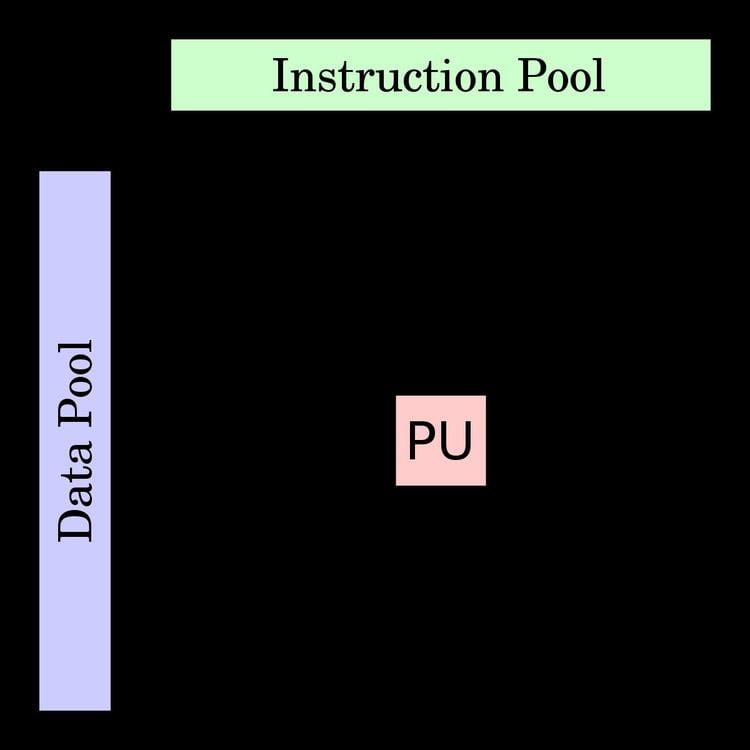 | ||
Flynn's taxonomy is a classification of computer architectures, proposed by Michael J. Flynn in 1966. The classification system has stuck, and has been used as a tool in design of modern processors and their functionalities. Since the rise of multiprocessing central processing units (CPUs), a multiprogramming context has evolved as an extension of the classification system.
Contents
- Classifications
- Single instruction stream single data stream SISD
- Single instruction stream multiple data streams SIMD
- Multiple instruction streams single data stream MISD
- Multiple instruction streams multiple data streams MIMD
- Single instruction multiple threads SIMT
- Diagram comparing classifications
- Further divisions
- Single program multiple data streams SPMD
- Multiple programs multiple data streams MPMD
- References
Classifications
The four classifications defined by Flynn are based upon the number of concurrent instruction (or control) streams and data streams available in the architecture.
Single instruction stream single data stream (SISD)
A sequential computer which exploits no parallelism in either the instruction or data streams. Single control unit (CU) fetches single instruction stream (IS) from memory. The CU then generates appropriate control signals to direct single processing element (PE) to operate on single data stream (DS) i.e., one operation at a time.
Examples of SISD architecture are the traditional uniprocessor machines like older personal computers (PCs; by 2010, many PCs had multiple cores) and mainframe computers.
Single instruction stream, multiple data streams (SIMD)
A computer which exploits multiple data streams against a single stream to perform operations which may be naturally parallelized. For example, an array processor or graphics processing unit (GPU)
Multiple instruction streams, single data stream (MISD)
Multiple instructions operate on one data stream. Uncommon architecture which is generally used for fault tolerance. Heterogeneous systems operate on the same data stream and must agree on the result. Examples include the Space Shuttle flight control computer.
Multiple instruction streams, multiple data streams (MIMD)
Multiple autonomous processors simultaneously executing different instructions on different data. MIMD architectures include multi-core superscalar processors, and distributed systems, using either one shared memory space or a distributed memory space.
Single instruction, multiple threads (SIMT)
Single instruction, multiple threads (SIMT) is an execution model used in parallel computing where single instruction, multiple data (SIMD) is combined with multithreading. This is not originally part of Flynn's taxonomy but a proposed addition.
Diagram comparing classifications
These four architectures are shown below visually. Each processing unit (PU) is shown for a uni-core or multi-core computer:
Further divisions
As of 2006, all the top 10 and most of the TOP500 supercomputers are based on a MIMD architecture.
Some further divide the MIMD category into the two categories below, and even further subdivisions are sometimes considered.
Single program, multiple data streams (SPMD)
Multiple autonomous processors simultaneously executing the same program (but at independent points, rather than in the lockstep that SIMD imposes) on different data. Also termed single process, multiple data - the use of this terminology for SPMD is technically incorrect, as SPMD is a parallel execution model and assumes multiple cooperating processes executing a program. SPMD is the most common style of parallel programming. The SPMD model and the term was proposed by Frederica Darema. Gregory F. Pfister was a manager of the RP3 project, and Darema was part of the RP3 team.
Multiple programs, multiple data streams (MPMD)
Multiple autonomous processors simultaneously operating at least 2 independent programs. Typically such systems pick one node to be the "host" ("the explicit host/node programming model") or "manager" (the "Manager/Worker" strategy), which runs one program that farms out data to all the other nodes which all run a second program. Those other nodes then return their results directly to the manager. An example of this would be the Sony PlayStation 3 game console, with its SPU/PPU processor.
